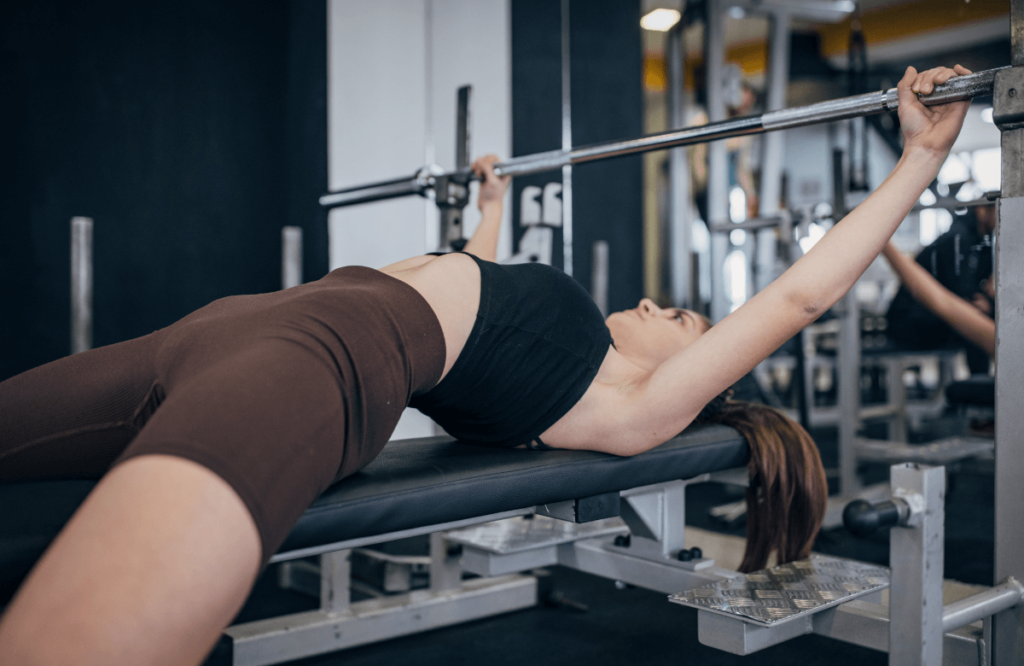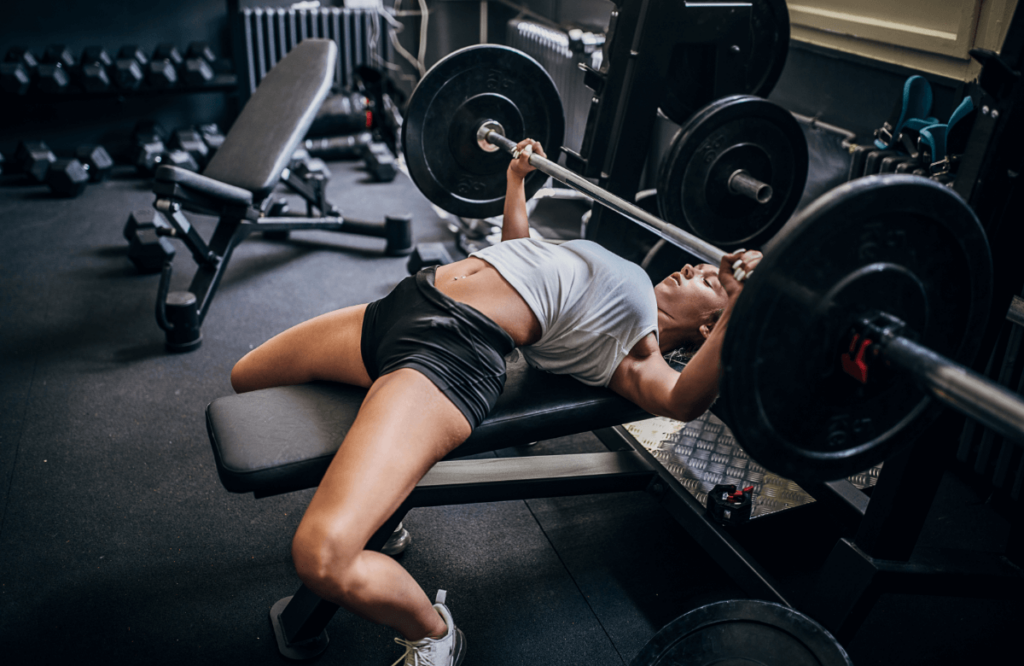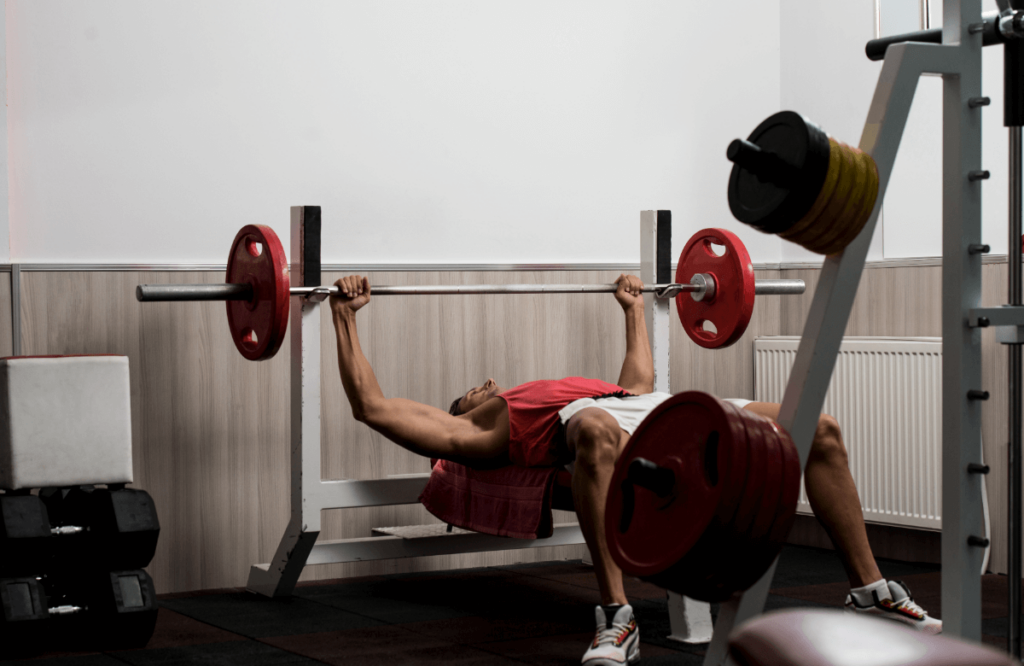Want to take your bench press to the next level? The secret may lie in the way you arch your back.
Uncover the potential benefits of this technique, from increased power to reduced injury risk.
But does the arch beat the classic flat-back press? And what are the potential downsides? Get ready to discover the science behind the arch and decide if it’s right for you.
Jump to:
What Is the Bench Press Arch Technique?
If you want to get into more technical territory, the arch refers to a form cue that dictates how your spine should be positioned while lying down on the bench. As its name implies, a moderate arch is formed by curving most of the back forward instead of staying flat on the surface.
The arch back bench press also involves slightly retracting your shoulder blades while pushing up the barbell. This helps to make sure your shoulders are in the correct position and prevents them from being over-extended during the lift.
What Are the Advantages of Performing a Bench Press Arch?
So how can your upper body musculature benefit from this form of exercise? Is it really worth the extra effort? Let’s take a look at some of the advantages:
Reduced Range of Motion
This one is an interesting point because most of us are conditioned to believe that a larger range of motion can result in better gains. But when it comes to arching your back during the press, this allows you to lower the barbell closer to your chest without having to move your shoulder blades too much.
The idea behind this is simple – there’s less work for the same amount of weight because the muscles don’t have to move as far. This results in a more efficient press since you can focus on generating maximal force instead of worrying about the range of motion. When your arms travel a shorter distance to reach the ideal shoulder positioning for this particular exercise, you use less energy and produce more power from the movement.
Improved Pec Activation
Since the shoulders and scapula are basically pinned to the bench, a lot of the work is done by your chest muscles. This creates an optimal environment for getting a nice pump in those pecs and helps to promote better pectoral activation. This also allows for increased control over the barbell since it won’t move around too much.
One particularly interesting aspect is that there’s a greater emphasis on the lower pectoral muscle group since the barbell has to travel further down and contract more as it’s pushed up. This leads to a better contraction of the chest muscles, which helps with building strength and mass in that area.
Enhanced Leg Drive
Believe it or not, one of the most essential aspects of getting a bigger chest involves using your lower body. By relying on a bench press arch, you can drive your legs into the floor for added stability and power throughout the movement. This helps to shift more of the work from the upper body muscles onto the larger leg muscles which are better-equipped to handle it.
When the force of the weight moves through your core and down to your legs, this increases the total amount of tension on the body which is ideal for building better strength and power. This can generate a much more explosive press since you’re using both your arms and legs to move the barbell.
Better Shoulder Position and Stability
If you’ve ever lifted a heavier weight while performing chest exercises and felt a bit wobbly or uncomfortable around your shoulders, you can leave those worries behind with a bench press arch. This technique helps to stabilize the shoulder area by creating a more solid platform for moving the weight.
The arch also allows you to drop the barbell closer to your chest without having to worry about slipping off or straining your shoulders too much. This is directly related to the way the back is arched since your shoulders and hips are practically what keep your body in place while you’re lying down on the bench. When this part is not moving with each rep, you can lift it with greater confidence and security.

Greater Overall Muscle Engagement
Overall muscle activation is often overlooked when it comes to strength training but it’s one of those key elements that can make a big difference. Many people tend to focus on specific muscle groups at the expense of others, but if you want to maintain proper bench press form you need to engage your entire body.
This is especially true when it comes to arching your back since the power you generate from each press has to be distributed evenly throughout all of your muscle groups to ensure that the barbell is moving in a consistent manner. As you get more comfortable with arching your back during the press, you can further refine your technique and increase your overall strength gains.
Safety Buffer Against Hyperextension Injuries
The risk of injury with heavy weights is undoubtedly one of the major concerns for any lifter. In particular, hyperextension injuries are a serious issue since they can occur if you don’t use the correct form. They’re directly related to overstretching your lower back to accommodate the weight, which in turn can lead to damage to the spinal discs.
By arching your back during the press, you can effectively reduce or eliminate the risk of developing these kinds of injuries. This is because the arched shape helps to keep your lower back from overstretching and ensures that you’re using the correct form. This is especially important for those who are lifting heavy weights as it can help to prevent any long-term damage that may occur from overstretching the spine.
Potential Drawbacks of Doing a Bench Press Arch
As with any other exercise, there are certain setbacks that can occur from performing an arched bench press. While some may argue that the benefits outweigh the potential drawbacks, it’s important to be aware of the injury risk that can come with this type of upper chest workout.
Increased Spinal Pressure
One of the biggest risks when arching your back is that it can lead to an increased amount of spinal pressure being applied to your discs and vertebrae. This can be an issue if you don’t keep your back arched throughout the entire press, since then there’s a risk of hyperextending your spine and causing damage to the discs.
When this occurs, your discs may be compressed or pushed out of alignment, leading to numbness in your lower back and possible sciatica. This can be particularly problematic if it’s left unchecked, especially if you keep performing the press with the incorrect form.
To avoid this scenario, it’s important to take caution when arching your back during the press. Pay close attention to your form and make sure that you’re consistently arching your back throughout the entire lift. If not, then it’s best to stop and re-evaluate your technique before attempting any heavy weights.
Risking Improper Form
You’ll probably find this exact same advice for any other exercise, as proper form is always essential for achieving the desired results. But this becomes especially important when it comes to arching your back during the press since incorrect form can lead to spinal pressure and damage.
The goal is to avoid an extreme arch that causes your spine to twist into a rather unnatural position. Instead, you should focus on keeping your back in an arched but neutral posture so that the force created by the barbell is spread evenly throughout your body. If not, then there’s a risk of overextending your spine and causing injury in the process.
Inadequate Muscle Activation
Bench press exercises are meant to target the chest, shoulders, and arms in order to build strength and power. While other areas of the body do participate in the movement – such as your core and legs – arching your back can cause these muscles to become overactive or underused. Both outcomes can lead to improper form and inefficient lifts.
Moreover, this can also limit the amount of muscle activation in your upper body since the arch technique shifts much of the workload onto your legs and core. As a result, your arms and chest may not be receiving the full benefit of the press, reducing your overall gains. You need to know which areas to focus on during each stage of the lift, starting from the initial setup to the final press.
Excessive Shoulder Strain
While the barbell bench arch promotes shoulder stability and a reduced range of motion, it can also increase the risk of shoulder strain. This is because as you arch your back and lower the weight towards your chest, the added pressure on your shoulders can cause them to become tight or strained.
Since you’re using your shoulder joint to keep your body in place while you press, you should always pay close attention to how it feels when arching. If any discomfort is present then you may need to adjust your form and/or lower the weight until you can safely perform each lift without putting more strain on your shoulders. If you do feel any pain, then it’s best to stop and rest until you can properly assess the cause.
Greater Chance of Developing Bad Lifting Habits if Not Monitored
Your bench press technique involves a lot more than just lying on a bench and arching your back. While both of these elements are important, you also need to keep an eye out for the other aspects of your form such as foot placement, hand grip, and head position. If any of these become misaligned or incorrect then it can lead to bad lifting habits that can reduce your performance and increase the risk of injury.
To ensure that you’re using proper form, you need to be mindful of all the components of the lift. This can be difficult to do on your own, so it’s always best to have a spotter or coach to help you with any adjustments that may be needed. If you need time to adjust to the arch technique then that’s perfectly okay, but be sure to monitor your progress and make any necessary changes as soon as you can.

How to Do the Bench Press Arch?
Even if bench pressing may look like a simple exercise, there is a definite technique you need to use in order to safely and effectively arch your back and facilitate the lift. Oftentimes, people underestimate the importance of other aspects aside from focusing on the curve of your spine which ultimately affects their performance.
Assume the Right Shoulder and Back Position
Believe it or not, most of the work comes from the upper portion of your body rather than the lower. This is mainly because the latter part of your back comes with a natural curve that is commonly referred to as the lordotic curve. As such, it can help to put your shoulder blades in a retracted position and slightly arch your upper back before you begin.
The key thing to do here is to position your shoulders downwards towards the bench itself and as far away from your ears as possible. This will help ensure that your shoulder blade muscles are activated and able to provide maximum support while you press. When you squeeze them tightly together, you minimize the potential risk of shoulder strain later on.
When you pin your shoulders to the bench, you’re essentially exaggerating the curve of your back without overloading your spine. This helps you to increase the range of motion while still keeping your back in a healthy position. This inherently supports your entire body, helping to keep it stable and reduce the overall risk of injury. However, the upper portion remains static and glued to the bench throughout the entire lift.
Create a Proper Brace
Bracing refers to the act of pressing your abdominal muscles against the bench as well as pushing down onto the ground with your legs. Doing this should help to keep your body in a secure and stable position as you press the weight, all while activating your core muscles to support your spine.
For you to fully take advantage of the consistent tension and efficiency of the arch technique, you need to pay attention to the way your core interacts with the bench. The idea is to create a rigid base by engaging your abs while squeezing your glutes.
This is commonly referred to as puffing your core, and it involves breathing in forcefully and holding the air inside your body while tensing your abdominal muscles to help maintain a stable foundation. This helps to promote consistent tension throughout the lift as well as aiding you in stabilizing the weight during each rep.
When you expand your rib cage, you’re essentially maximizing your arch and minimizing bar travel, which helps to reduce unnecessary strain and pressure on your spine. This also helps to isolate the intended muscle groups, allowing you to fully activate them without having to worry about any distractions or imbalances.
The Correct Foot Placement
When you strategically position your feet on the ground, you can help generate additional power and push off with your legs during each repetition. This, in turn, creates a more noticeable arch that can help you to move the weight more efficiently.
Generally speaking, lifters tend to keep their feet tucked underneath the bench so that they can use their legs to create additional tension and explosion. This also helps to keep everything in check as you press, allowing your body to stay properly aligned while reducing the risk of any spinal instability. But in this case, you don’t necessarily need to tuck your feet underneath the bench.
You can also keep them planted firmly on the ground, slightly wider than shoulder-width apart. Keeping your toes pointed outward and your heels pressed down will help you stabilize your body and give you a better chance of pushing the weight up more easily.
A rule of thumb is to keep your feet as far back as you comfortably can while still being able to move the weight without any noticeable strain on your back. Remember, arching your back reduces the range of motion while simultaneously creating more tension throughout your body. So, you need to find a balance between tension and mobility that works best for you and allows you to perform each rep with maximum control and comfort.
Ways to Get into the Arch Position
The final and perhaps most crucial aspect of the bench press arch technique is getting into position. Depending on your body type, you may find it somewhat challenging to get into the right posture and activate several muscle groups at once.
A good way to start is by implementing the bridge technique. This involves lying on the bench with your head and shoulder blades off the edge, then arching your back by pushing down into the ground with your feet. This so-called glutes bridge helps to activate your posterior chain while allowing you to maintain a lower back arch.
Once you have a good grip on the bar, you should begin the lift by pushing your butt off the bench and arching your back. This should create a bridge between your upper body and lower body, allowing you to move with maximum efficiency while reducing any strain on your spine. You can use your toes to press down into the ground, helping to create additional tension in your legs and core.
Another useful practice is to use either side of the rack to get into position. This allows you to use the sides of the rack as a support system, keeping your body in place and having complete control over each repetition. This is especially useful when you’re just starting out with the technique and need to find your balance and range of motion before attempting heavier lifts.

FAQs
Is it better to arch back or flat back bench press?
Depending on the type of lift you’re attempting to do, arching your back can offer several advantages over a flat back on the bench. Arching your back can help reduce the range of motion while improving pec activation and overall muscle engagement, as well as improving shoulder position and stability.
How much can you arch your back when benching?
While you can generally arch as much or as little as you see fit, it’s important to find the right balance between tension and mobility. It should be comfortable enough to allow you to move the weight without any noticeable strain on your back.
Is it safe to bench with an arched back?
As long as you maintain proper form and technique, you shouldn’t experience any adverse effects from arching your back while bench pressing. It’s actually an effective way to help reduce strain and pressure on your spine, as well as isolate the intended muscle groups more effectively.














